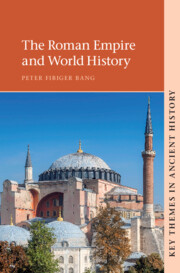Refine search
Actions for selected content:
24162 results in Ancient history
Chapter One - Cyclades
-
- Book:
- The Archaeology of the Cyclades in the Roman and Late Antique Periods
- Published online:
- 23 October 2025
- Print publication:
- 06 November 2025, pp 1-27
-
- Chapter
-
- You have access
- HTML
- Export citation
Copyright page
-
- Book:
- The Archaeology of the Cyclades in the Roman and Late Antique Periods
- Published online:
- 23 October 2025
- Print publication:
- 06 November 2025, pp iv-iv
-
- Chapter
- Export citation
Index
-
- Book:
- The Archaeology of the Cyclades in the Roman and Late Antique Periods
- Published online:
- 23 October 2025
- Print publication:
- 06 November 2025, pp 257-266
-
- Chapter
- Export citation
Chapter Six - Conclusion
-
- Book:
- The Archaeology of the Cyclades in the Roman and Late Antique Periods
- Published online:
- 23 October 2025
- Print publication:
- 06 November 2025, pp 140-156
-
- Chapter
- Export citation
References
-
- Book:
- The Archaeology of the Cyclades in the Roman and Late Antique Periods
- Published online:
- 23 October 2025
- Print publication:
- 06 November 2025, pp 235-256
-
- Chapter
- Export citation

The Roman Empire and World History
-
- Published online:
- 31 October 2025
- Print publication:
- 30 October 2025
Dedication
-
- Book:
- The Roman Empire and World History
- Published online:
- 31 October 2025
- Print publication:
- 30 October 2025, pp v-vi
-
- Chapter
- Export citation
Figures
-
- Book:
- The Roman Empire and World History
- Published online:
- 31 October 2025
- Print publication:
- 30 October 2025, pp viii-x
-
- Chapter
- Export citation
Chapter 6 - Resistance, Rebellion and Renewal
-
- Book:
- The Roman Empire and World History
- Published online:
- 31 October 2025
- Print publication:
- 30 October 2025, pp 153-176
-
- Chapter
- Export citation
Contents
-
- Book:
- The Roman Empire and World History
- Published online:
- 31 October 2025
- Print publication:
- 30 October 2025, pp vii-vii
-
- Chapter
- Export citation
Copyright page
-
- Book:
- The Roman Empire and World History
- Published online:
- 31 October 2025
- Print publication:
- 30 October 2025, pp iv-iv
-
- Chapter
- Export citation
Chapter 2 - The Expanding World of Warring States
-
- Book:
- The Roman Empire and World History
- Published online:
- 31 October 2025
- Print publication:
- 30 October 2025, pp 28-55
-
- Chapter
- Export citation
Chapter 3 - Among Empires
-
- Book:
- The Roman Empire and World History
- Published online:
- 31 October 2025
- Print publication:
- 30 October 2025, pp 56-85
-
- Chapter
- Export citation
Conclusion - Beyond Globalization – The World Histories for Rome
-
- Book:
- The Roman Empire and World History
- Published online:
- 31 October 2025
- Print publication:
- 30 October 2025, pp 177-186
-
- Chapter
- Export citation
Bibliographical Essay
-
- Book:
- The Roman Empire and World History
- Published online:
- 31 October 2025
- Print publication:
- 30 October 2025, pp 187-189
-
- Chapter
- Export citation
Chapter 5 - Premodern Globalization?
-
- Book:
- The Roman Empire and World History
- Published online:
- 31 October 2025
- Print publication:
- 30 October 2025, pp 119-152
-
- Chapter
- Export citation
Index
-
- Book:
- The Roman Empire and World History
- Published online:
- 31 October 2025
- Print publication:
- 30 October 2025, pp 223-234
-
- Chapter
- Export citation
Bibliography
-
- Book:
- The Roman Empire and World History
- Published online:
- 31 October 2025
- Print publication:
- 30 October 2025, pp 190-222
-
- Chapter
- Export citation
Preface
-
- Book:
- The Roman Empire and World History
- Published online:
- 31 October 2025
- Print publication:
- 30 October 2025, pp xi-xvi
-
- Chapter
- Export citation
Chapter 1 - Rome and Pre-colonial World History
-
- Book:
- The Roman Empire and World History
- Published online:
- 31 October 2025
- Print publication:
- 30 October 2025, pp 1-27
-
- Chapter
-
- You have access
- HTML
- Export citation
